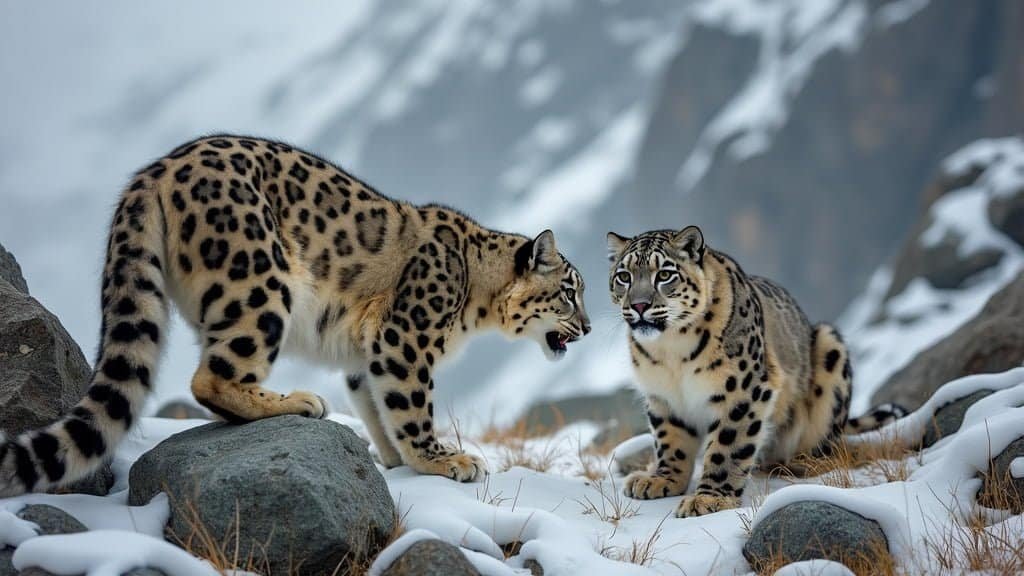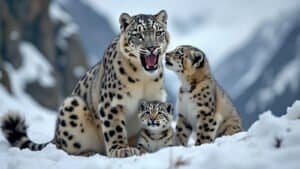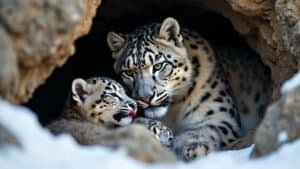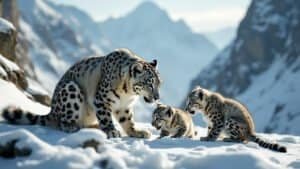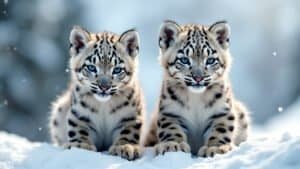Introduction
Snow leopards, elusive inhabitants of the rugged mountains of Central Asia, have unique and fascinating mating behaviors
This article delves into the various methods snow leopards use to attract mates, from scent marking and vocalizations to the role of pheromones. We will explore the timing of their mating season, the influence of their habitats, and the challenges they face
Additionally, we’ll look at how snow leopards find mates in the wild and the benefits their offspring gain from these behaviors. By understanding these aspects, we can gain deeper insights into the lives of these magnificent creatures
Methods of Attracting Mates
Snow leopards use a combination of scent marking, vocalizations, and pheromones to attract mates. These methods are essential for their communication in the vast and rugged terrains they inhabit. Understanding these behaviors provides insight into the social and reproductive lives of these elusive cats
Scent Marking Techniques
Scent marking is a primary method snow leopards use to communicate and attract mates. This behavior involves depositing scents from their glands onto rocks, trees, and the ground
According to a study published in the journal Mammalian Biology in 2016, scent marking serves multiple purposes: it marks territory, conveys information about the individual’s reproductive status, and helps in locating potential mates (Johansson et al., 2016)
Snow leopards possess specialized glands on their cheeks, tail base, and paws that secrete pheromones. When a snow leopard rubs its face or body against a surface, it leaves behind these chemical signals
These scents are unique to each individual, allowing snow leopards to recognize each other. During the mating season, females increase their scent marking frequency to signal their readiness to mate. Males, in turn, respond by marking over the females’ scents, thereby indicating their interest and presence
In addition to rubbing, snow leopards also use urine spraying to mark their territory and attract mates. This behavior involves the snow leopard backing up to a vertical surface and spraying urine in a fine mist
The composition of the urine contains specific chemicals that convey the leopard’s age, sex, and reproductive status. This method ensures that the scent remains at nose level for other passing snow leopards, making it an efficient way to communicate across vast distances
Vocalizations and Communication
Vocalizations are another crucial aspect of snow leopard mating behaviors. Snow leopards are known for their distinctive calls, especially during the mating season. These vocalizations include moans, growls, and chuffing sounds
A study by McCarthy and Chapron (2003) highlighted that snow leopards’ calls can travel long distances, which is vital in the expansive and rugged terrains they occupy
Females typically initiate vocal communication to attract males. They produce a series of moaning calls that increase in frequency and intensity as they approach estrus. These calls serve as both an invitation and a signal of the female’s reproductive status
Males respond with their own vocalizations, which can include a mix of growls and chuffing sounds. These interactions help both parties locate each other and establish a connection before meeting
Interestingly, snow leopards also use vocalizations to establish dominance and deter potential rivals. A male may use loud calls to warn other males to stay away from a female he is interested in. This acoustic communication reduces the need for physical confrontations, which can be risky and energy-consuming
Role of Pheromones
Pheromones play a significant role in the mating behaviors of snow leopards. These chemical signals are crucial for conveying information about an individual’s reproductive status and readiness to mate. Pheromones are secreted through various glands and are detected by other snow leopards through scent marking and direct contact
The vomeronasal organ, located in the nasal cavity, is specialized for detecting pheromones. When a snow leopard encounters a scent mark, it engages in a behavior known as the Flehmen response, where it curls back its lips and inhales deeply
This action helps the snow leopard draw pheromones into the vomeronasal organ, allowing it to analyze the chemical composition and gather information about the scent’s origin
During the mating season, female snow leopards produce specific pheromones that indicate their fertility and readiness to mate. Males, upon detecting these pheromones, become more attentive and follow the scent trail to locate the female
This chemical communication ensures that mating occurs at the optimal time for reproductive success
Mating Season and Habitats
The mating season and habitats of snow leopards significantly influence their reproductive behaviors. These elusive cats have adapted to the harsh environments of Central Asia, where they face unique challenges and opportunities during the mating season
Timing of Mating Season
The mating season for snow leopards typically occurs from January to mid-March. This period aligns with the harsh winter conditions in their mountainous habitats, which influences their behavior and physiology
According to the International Union for Conservation of Nature (IUCN), the timing of the mating season ensures that the birth of cubs coincides with the warmer months, providing better survival conditions for the young (IUCN, 2020)
During this season, female snow leopards undergo estrus, a period of fertility lasting about 7-10 days. The short duration of estrus necessitates that both males and females be highly attuned to the signals indicating readiness to mate
Increased vocalizations, scent marking, and physical activity are observed during this period as both sexes seek to maximize their chances of finding a suitable mate
Impact of Habitat on Mating Behavior
Snow leopards inhabit some of the most rugged and remote terrains in the world, including the Himalayas, Altai Mountains, and Tibetan Plateau
These habitats are characterized by steep cliffs, rocky outcrops, and vast expanses of snow and ice. The challenging environment plays a significant role in shaping the mating behaviors of snow leopards
The vastness and inaccessibility of their habitats mean that snow leopards are typically solitary animals, with large home ranges that can overlap. This solitary nature requires efficient communication methods to locate and attract mates
Scent marking and vocalizations are particularly crucial in these environments, as they allow snow leopards to convey their presence and reproductive status over large distances without the need for direct contact
Moreover, the rugged terrain provides natural pathways and landmarks that snow leopards use for navigation and marking territories. These features also serve as strategic points for leaving scent marks and vocalizing, increasing the chances of attracting a mate
Research by the Snow Leopard Trust has shown that snow leopards often use ridgelines and valley bottoms as travel routes and marking sites, optimizing their movements in the harsh landscape (Snow Leopard Trust, 2018)
Challenges Faced During Mating Season
The mating season presents several challenges for snow leopards. The harsh winter conditions can make travel and communication difficult, as deep snow and strong winds may obscure scent marks and dampen vocalizations
Additionally, the sparse population density of snow leopards means that individuals may have to travel long distances to find a mate
Another challenge is competition among males for access to receptive females. Male snow leopards may engage in aggressive behaviors, such as vocal displays and physical confrontations, to establish dominance and secure mating opportunities. These interactions can be risky, as injuries sustained during fights can have serious consequences in the harsh environment they inhabit
Human activities also pose significant challenges to snow leopards during the mating season. Habitat fragmentation, caused by infrastructure development and livestock grazing, can disrupt traditional travel routes and marking sites
Additionally, the presence of humans and livestock can lead to increased human-wildlife conflicts, further complicating the mating season for snow leopards
Despite these challenges, snow leopards have evolved various strategies to cope with their environment and successfully reproduce. Their ability to communicate over long distances, combined with their adaptability to the rugged terrain, allows them to find and attract mates even in the most challenging conditions
Finding a Mate in the Wild
Snow leopards face numerous challenges in finding a mate due to their solitary nature and the vast, rugged terrains they inhabit. Their behaviors and strategies for locating potential partners are finely tuned to their unique environments
Search and Courtship Behaviors
The process of finding a mate begins with snow leopards actively searching for potential partners during the mating season. Males and females both increase their movement patterns, covering larger areas to maximize their chances of encountering each other
According to the Snow Leopard Conservancy, these searches are often conducted along well-established travel routes that are frequently marked with scent (Snow Leopard Conservancy, 2019)
Courtship behaviors in snow leopards involve a combination of vocalizations, scent marking, and physical displays. When a male detects a female’s scent mark, he will follow the trail, often calling out to announce his presence. Females respond with their own calls, and the two will engage in a series of vocal exchanges that help them locate each other
Once in proximity, the courtship continues with mutual scent marking, where both individuals rub against the same surfaces, mixing their scents
This behavior not only reinforces their bond but also signals their readiness to mate. Physical displays, such as rolling on the ground and gentle pawing, further establish the connection between the pair
Interaction Between Males and Females
Interactions between male and female snow leopards during the mating season are characterized by a delicate balance of communication and cautious approach. Unlike many other big cats, snow leopards are generally less aggressive during courtship, focusing more on mutual acceptance and cooperation
When a male approaches a female, he does so cautiously, using a series of chuffing sounds and low-frequency calls to signal his intentions
If the female is receptive, she will respond with similar vocalizations and allow the male to come closer. The pair may then engage in playful behaviors, such as nuzzling and grooming, to strengthen their bond
During this period, the female’s behavior is critical. If she shows signs of aggression or disinterest, the male may retreat to avoid conflict. However, if she is receptive, the pair will continue to interact closely, often for several days, before mating occurs
This prolonged interaction helps ensure that the female is indeed ready to mate and that the bond between the pair is strong
Signs of Readiness to Mate
Recognizing the signs of readiness to mate is crucial for both male and female snow leopards. For females, increased scent marking and vocalizations are primary indicators. A female in estrus will leave more frequent and concentrated scent marks along her travel routes, signaling her reproductive status to any nearby males
Behaviorally, a female ready to mate will show increased tolerance toward males, allowing them to approach and engage in courtship behaviors. She may also exhibit specific postures, such as crouching and rolling, that signal her readiness to the male
For males, detecting these signs involves a keen sense of smell and attentive behavior. Upon encountering a female’s scent mark, a male will often perform the Flehmen response to analyze the pheromones and determine her reproductive status. If the analysis confirms that the female is in estrus, the male will increase his efforts to locate her, using both scent trails and vocal cues
Once a pair has formed, mating occurs multiple times over several days, ensuring that the female has the best chance of conceiving. This repeated mating behavior is common in many big cat species and helps synchronize the female’s ovulation with the act of mating
Benefits to Offspring
The reproductive behaviors of snow leopards not only ensure successful mating but also have significant benefits for their offspring. These behaviors influence the survival and development of cubs, contributing to the overall fitness and resilience of the species
Role of Parental Behavior
Parental behavior plays a crucial role in the survival of snow leopard cubs. After a successful mating, the female prepares a den in a secluded area, often in rocky crevices or caves, to provide a safe environment for birthing and raising her cubs
According to research by the Snow Leopard Trust, dens are typically chosen for their protection from predators and harsh weather conditions (Snow Leopard Trust, 2020)
Female snow leopards are solely responsible for the care of their cubs. They exhibit high levels of maternal investment, spending most of their time in the den during the early weeks of the cubs’ lives
This period is critical for the cubs’ development, as the mother provides warmth, protection, and milk. The close bond formed during this time ensures that the cubs receive the necessary care and nurturing to survive the initial vulnerable stage of their lives
As the cubs grow, the mother begins to leave the den for short periods to hunt, gradually increasing the duration as the cubs become more independent. She introduces them to solid food by bringing back prey, which the cubs learn to eat and eventually hunt themselves. This teaching process is vital for the cubs’ development of hunting skills and survival instincts
Survival Strategies for Cubs
Snow leopard cubs are born blind and helpless, weighing around 11 to 20 ounces. Their initial survival depends entirely on their mother’s care. The den provides a secure environment where the cubs can grow and develop without the immediate threat of predators or harsh weather
During the first few months, the mother stays close to the den, only venturing out to hunt. She often caches her kills near the den to minimize the time spent away from her cubs. This strategy ensures that the cubs have a steady supply of food and are not left unattended for long periods
As the cubs grow stronger, the mother begins to take them on short excursions outside the den. These outings help the cubs acclimate to their environment and develop necessary skills for survival. By the time they are around 3 to 4 months old, the cubs start to follow their mother on longer hunting trips, learning to stalk and capture prey
Survival strategies also include the development of physical and behavioral adaptations. The thick fur and large paws of snow leopard cubs provide insulation against the cold and enhance their ability to navigate snowy and rocky terrains. Additionally, their cryptic coloration offers camouflage, reducing the risk of predation
Long-term Impacts on Population
The reproductive behaviors and survival strategies of snow leopards have long-term impacts on their population dynamics. High maternal investment and effective survival strategies increase the likelihood that cubs will reach maturity and contribute to the population’s genetic diversity
The survival rate of snow leopard cubs to adulthood is influenced by several factors, including maternal care, availability of prey, and habitat conditions
Studies have shown that in areas with abundant prey and stable habitats, snow leopard populations tend to have higher cub survival rates (McCarthy et al., 2016). Conversely, in regions where prey is scarce or habitats are fragmented, cub mortality rates can be higher, affecting the overall population growth
Conservation efforts aimed at protecting snow leopard habitats and ensuring prey availability are crucial for the long-term sustainability of their populations. By maintaining healthy ecosystems, we can support the reproductive success and survival of snow leopard cubs, ultimately contributing to the preservation of this iconic species
Conclusion
Snow leopards employ a range of fascinating behaviors to attract mates and ensure the survival of their species. From scent marking and vocalizations to the role of pheromones, these methods facilitate communication and mating in the vast and rugged terrains they inhabit
The timing of their mating season and the unique challenges of their habitats further shape their reproductive strategies. Finding a mate involves careful search and courtship behaviors, with both males and females displaying specific signs of readiness
The benefits to their offspring are significant, with high maternal investment and effective survival strategies enhancing cub survival rates. Understanding these behaviors and the factors influencing them is crucial for the conservation of snow leopards, ensuring that these magnificent creatures continue to thrive in their natural habitats
